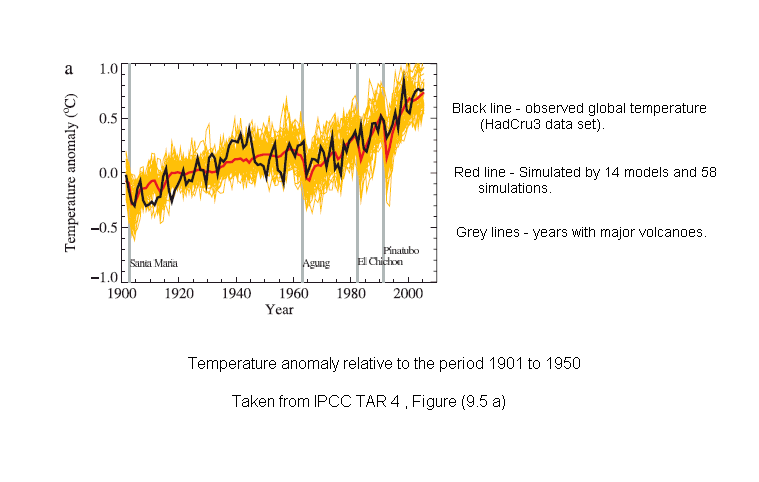CLIMATE MODELS
In addition to regular daily and seasonal changes, the earth’s temperature has periods of warming and cooling. During the 20th century there were two very similar warming period, from 1909 to 1944 and from 1975 to 2005. There was also a cooling period from 1944 to 1975. Models of the climate are used to estimate future changes to temperature.
Simulation of 20th Century Temperature
Climate models are used to calculate what changes in climate will occur due to natural and artificial “forcing”. The models are often referred by the letters GCM (Global Circulation Models) or AOGCM (Atmosphere-Ocean coupled GCM). Confidence in the conclusions of the models depends, in part, on how well they have simulated changes in the past.IPCC Technical Assessment Report
TemperatureThe IPCC Technical Assessment Report 4 (TAR4) presents a graph (Figure 1) showing the average results of 58 simulations using 14 models. The graph is for global mean surface temperature anomaly relative to the average for the period 1901 to 1950 is zero. It covers the period 1900 to 2005. This graph is reproduced below.
Choice of Models Used For Simulation of Temperature
As a comparison we analysed 26 simulations from 7 models using the 20c3m and SRESa1b scenarios. In reality, until 2000 the simulations are the same (except there are fewer simulations for the a1b scenario) for both scenarios. The SRESa1b scenario was used by the IPCC to extend their comparison up to 2005 and we have done the same. The choice of models was based on those listed on table 6 of the IPCC “General Guidelines on the Use of Scenario Data for Climate Impact and Adaptation Assessment”, Version 2, June 2007. The models we used and the reason for our choice are given in the following table.In general we went for the latest version of a model from the same centre but also took account of the number of scenarios and the length of the simulation period. To avoid the results being biased in favour of models with a large number of simulations, the results for each model were first averaged, then the average of all models was calculated.
| Modelling Centre | Country | Model(s) in IPPC Table 6 | Models Used | Notes |
| Commonwealth Scientific and Industrial Research Organisation (CSIRO) | Australia | CSIRO-Mk2 | CSIRO Mk3.0 | |
| Max Planck Institut fur Meteorologie. (MPI) | Germany | ECHAM4/OPYC ECHAM3/LSG |
ECHAM5/ MPI-OM | |
| Hadley Centre for Climate Prediction and Research. (UKMO) | UK | HadCM2 and HadCM3 | UKMO HadCM3 | In one set of files a missing value was replaced by previous year. |
| Canadian Centre for Climate Modelling and Analysis (CCCMA) | Canada | CGCM1 And CGCM2 | CGCM3.1 (T47) | Has 5 scenarios |
| Geophysical Fluid Dynamics Laboratory (GFDL) | USA | GFDL-R15 and GFDL-R30 | GFDL CM2.1 | |
| National Centre for Atmospheric Research (NCAR) | USA | NCAR DOE-PCM | PCM | |
| National Institute for Environmental Studies (MIROC) | Japan | CCSR-NIES | MIROC3.2 (medres) | Covers longer period than ‘hires’ model. |